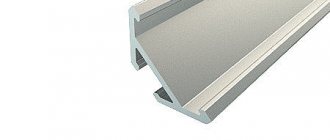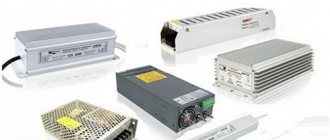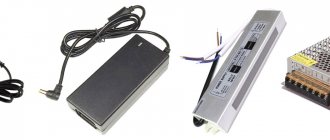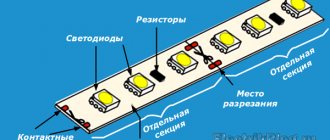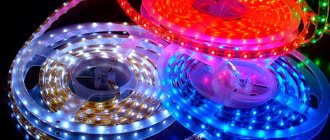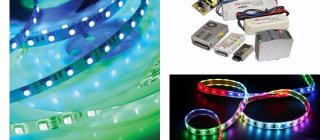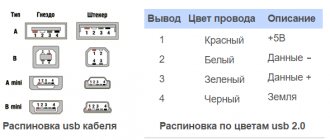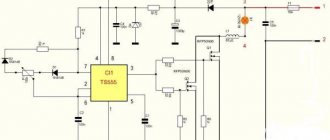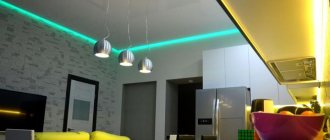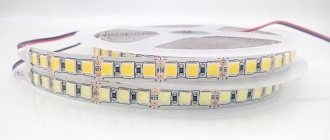What is a power supply for LED strip?
The power supply for the LED strip is a constant voltage source of 5, 12, 24 or 36 volts (48 volts are also available). It is used to convert alternating voltage from a 220 V network into a direct voltage of a certain level necessary for the operation of the LED strip. Sometimes power supplies for LED strips can be called LED drivers, but this is not entirely true. The term "LED driver" is most often used for power supplies to which LEDs are connected, which require a certain value of supply current. LED drivers implement a current stabilization mechanism that is limited to a certain value, but power supplies for LED strips do not have such a current limitation.
The LED strip is powered by a constant voltage, and the current flowing through the LEDs of the LED strip is limited using resistors installed in series with the SMD LEDs on the strip itself. The task of the power supply is to maintain the required voltage level, so it is not entirely appropriate to apply the term “driver for LED strip” to it.
What should you consider before purchasing?
The transformer for LED lighting elements is selected based on three main criteria:
- Input and output characteristics. The power supply is connected on one side to a 220 volt network, and on the other side to a 12 volt strip. This is the most popular option, but you may need to install a 24 or 36 volt backlight. Accordingly, the output of the power supply must have an equivalent voltage. There are universal devices designed for 12 volts and 24 volts, depending on the characteristics of the tape. Their price will be higher.
- Power. To prevent the LED strip from malfunctioning and the transformer itself from burning out, the power level of the latter should not be lower than the load of the lighting device. This is in theory, but in practice you should select a power supply whose power exceeds the equivalent parameter of the tape by 25-30%. Determining the required value is quite simple and you can easily do the calculation yourself (see above).
- Protection from external factors. At this stage, it is necessary to evaluate the operating conditions of the 12V tape: dust, moisture, direct contact with water, installation outdoors or work in a dry room. In each case, you need to choose different power supply designs. For rooms with normal humidity levels, interior models that are not protected from contact with water are suitable. For bathrooms and swimming pools, a sealed aluminum version should be used.
Manufacturer's choice
The market offers many Chinese “nameless” devices. Their price is noticeably lower. But in this case, it is difficult to predict how long such a device and the 12 volt tape connected to it will last.
The most popular products are from the Mean Well brand (Taiwan). The product range includes models for dry rooms and for outdoor use. This manufacturer offers many universal versions of power supplies designed for voltages of 12 volts and 24 volts.
If in the future you want to increase the illuminated area, you can simply replace the tape. In this case, the power supply will remain the same. Another manufacturer that is popular is Haitalk. Its products are offered at a more affordable price.
Calculation of power supply power for LED strip
The output voltage is the main characteristic of the power supply for an LED strip; if it is less, the LED strip simply will not emit light, and if it is more, something on it will burn out. Next they look at the power of the power supply, i.e. it should easily produce a certain current, which should be enough to operate all connected LED strips in their normal operating mode.
When designing LED lighting or decorative lighting using LED strips, the power of the power supply is calculated. The calculation is made to ensure that all connected LED strips shine with the required brightness, and the power supply for the LED strips is not overloaded during operation.
How is the power supply power for LED strips calculated? Everything is very simple, you just need to know the parameters of all LED strips connected to the power supply, i.e. you need to calculate the power consumption of all LED strips.
You might be interested in this Link to article: What determines the power of an LED strip
In the characteristics of the LED strip, the power is indicated per linear meter; if separate sections of LED strips with the same characteristics are connected to the power supply, then the indicated power per linear meter should be multiplied by the total length of the LED strips. Next, you need to add a margin of 20% to 30% to the result obtained, and round the resulting result to a larger integer multiple of ten.
It turns out that the calculated power of the power supply for LED strips will be greater than the actual consumption. This is done to ensure that the power supply does not operate beyond its capabilities, overheat and fail.
What you need to consider before buying a transformer for 12 volt diode strip
When you have decided which type of transformer for 12-volt LED strips best suits your requirements, it’s time to discuss important details before going to the store.
So, what is important to consider:
- Think over and prepare in advance a place to install the power supply. It is better not to place it in plain sight, but you should not place it in conditions where air cannot circulate freely. This is important to avoid excessive heat.
- Do not place the power supply near curtains or other flammable objects. There have been known cases of fire caused by a heating block.
- Calculate the power of the power supply before going to the store. Its power should be 20-30% greater than the total power of all LED devices. Read below on how to perform these calculations. If you make the wrong calculations, you risk that the LEDs will quickly fail.
- Assess the humidity of the room where you plan to install LED lighting. Then decide which type of power supply is most suitable.
- Decide on the size of the power supply.
- When purchasing, you will probably notice the letters IP and two numbers after them. This marking can also help you make your choice. The first number shows the degree of protection from various particles, as well as the degree of protection of a person from electric shock. The higher the number of this indicator, the better the protection. The second digit is responsible for protecting equipment from dampness and humid air. The higher the number, the better this indicator.
The rules are not at all complicated; if you follow them together, you can greatly extend the life of the transformer for connecting the diode strip.
What kind of block is needed for LED strip?
We have already discussed the main parameters of power supplies for LED strips above: supply voltage and power. It remains to consider other features and characteristics that are taken into account when choosing them.
In addition to voltage and power, power supplies for LED strips also differ in the type of design (case), degree of protection from external influences and functionality. Each of these options provides some advantages or limitations for use in different environments.
Three main types of power supplies for LED strips:
1. In a plastic case. 2. In a metal case with perforation. 3. Sealed in aluminum housing.
The power supply for LED strips in a plastic case can be similar to the power supply from a laptop or the power supply from various devices, for example, a battery charger for a powerful router and others. As a rule, low-power power supplies have a plastic case and can only be used indoors. They have passive cooling through the body, so they cannot withstand strong overloads.
The power supply for LED strip in a metal case with perforation usually has more than average power and corresponding dimensions. The radio components in them are cooled by air circulating in the case, and in powerful models a fan can be installed for forced airflow, which can be accompanied by a lot of noise. The advantage of such power supplies is the presence of a large number of pins, mainly for fairly powerful models, and a voltage level regulator, i.e. If necessary, they can be slightly adjusted. They are installed mainly in shields, where they will be protected from dust.
Sealed power supplies for LED strips in an aluminum case are well protected from dust and moisture. They are cooled passively through the case; for connection to the 220V network and to the LED strip there are wire sections. They can be installed both indoors and outdoors.
IP rating of LED power supplies
The protection class of a power supply affects the conditions in which it can be used. The most common power supplies for LED strips in a plastic case or in a metal case with perforation have a protection class of IP20 or IP40. This means that they can be used in dry rooms with a moderate amount of dust; it is better to hide perforated ones in switchboards, otherwise over time they will become completely clogged with dust.
Power supplies for LED strips in aluminum sealed cases have a protection class of at least IP65, and they can already be used in bathrooms and on the streets under a canopy. For outdoor use, more protection is required and the housing must be IP67 rated. There are even more protected power supplies with IP68 and even IP69. They can already withstand direct exposure to jets of water and even complete immersion in water up to 1 m.
Types of power supplies for LED strips by functionality
1. The most common ones, performing only the function of powering the LED strip. 2. Power supplies with a built-in dimmer for brightness adjustment. 3. Power supplies for LED strips with remote control. 4. The most expensive combined power supplies with a control panel and a dimmer.
The functionality of the power supply allows you to save space and increase ease of use, so as not to have many different devices in one place. In the most expensive option, instead of three devices, you can install only one power supply for the LED strip, in which everything is already included. At the same time, the simplest power supplies without bells and whistles can boast of their small size.
Leaky power supply
Let's start with the most common one - a leaky power supply. It is a metal box with a perforated body.
These types are most often used for lighting inside dry rooms - bedrooms, halls, corridors, offices. They do not have any moisture protection and are labeled IP20.
The popularity of these blocks is explained by three factors:
- cheapness
- longer service life due to better cooling conditions
- you can easily find high-power units (over 100W)
If you buy a similar unit from a quality manufacturer, this will be the best option for your lighting. However, don’t expect it to last longer than the tape itself.
Sooner or later they fail. For what reasons this happens and how this can be avoided, read the article at the link below.
Such blocks are also produced in Slim format. Moreover, a very large model with a width of 10-15 cm can be the same in power as Slim models, which are no wider than a matchbox.
True, the build quality and durability suffer from this. If large copies need to be selected with a power reserve of 30%, then for Slim devices this reserve will already be at least 50%.
Read more about how to correctly select power using just one universal formula.
Well, don’t forget that the larger the box, the more functionality it can carry. In addition to a simple transformer, you can install both a dimmer and remote control.
Buy one device and get 3 in 1.
All dimensions, of course, depend on power. For example, for low-power lighting (60-80W), even miniature models mounted on a DIN rail are suitable.
But the most important thing to remember is that all such blocks are used only in dry rooms. They cannot be mounted:
- in the bathroom
- in the kitchen near the sink
- in stock
- on the roof
- and especially on the street
You can often find small laptop power supplies.
1 of 2
For short sections of low-power LED strip, they can also be considered a completely acceptable option.
We will not consider miniature adapters that resemble phone chargers.
They are designed for very specific and low-power lighting, and are often sold complete with a strip.
There is no need to choose anything here and rack your brains with selecting power.
DIY power supply for LED strip
Let’s immediately clarify one point: it’s not profitable to independently develop, solder and assemble power supplies according to various circuits for LED strips in our time, and we won’t even consider this option.
Nowadays, there are many different devices that are equipped with external power supplies of 12 V or more, and each home has several that can easily serve as a power supply for an LED strip, provided the power is suitable.
If you don’t have such a power supply from old devices, then your neighbor probably has one, or you can buy one very cheaply at a flea market, or on ad sites. As a powerful power supply, you can consider a computer power supply. Old system units have power supplies with a power of 250 W to 400 W; modern computers do not use these and sell them for pennies. And they, by the way, have outputs with voltages of 5 V, 12 V and 24 V, so you can record any type of LED strips.
There are power supplies from laptops; the voltage in them can be 18 V or more. To connect an LED strip to them, you will need to use a DC-DC step-down voltage converter. In China, on AliExpress, such converters cost pennies, the main thing is to choose the right power.
There is a category of DC-DC converters that have both voltage and current regulation. In this case, they can act as a voltage source and a dimmer to adjust the brightness of the LED strip.
It is better not to use linear voltage regulator circuits, because they will have large losses and will require a bulky radiator to cool powerful transistors. Pulse converters greatly benefit in this regard.
Transformer power determination
Depending on the type of diodes provided in the strip, the input supply voltage can be different: 12V, 24V, 36V. The higher the value of this parameter, the more expensive the lighting device and a more powerful power supply will be required, which is also offered at a high price. In order not to make a mistake and choose the right model, you must first calculate the power of the transformer.
To do this, you just need to decide which version of the tape you need. You should also calculate the sufficient level of illumination in the area where the lighting will be installed. The manufacturer usually indicates the power of 1 m of LED strip in the product characteristics. By multiplying the value of this parameter by the total length of the diode strip, you can obtain the level of load created on the transformer.
For example, if the power of 1 m of tape is 7.2 W, and its total length is 10 m. Multiplying these values, you get 72 W - the estimated load of the connected lighting fixture. But to choose a 12-volt power supply, it is recommended to add a small power reserve to the obtained value.
You should not save, which means you can take a reserve of 30%. Accordingly, the final value of the transformer power for the LED strip is 93.4 W.
Connecting the LED strip to the power supply
When connecting an LED strip to a power supply, you need to follow some rules for connecting individual sections of LED strips. For example, it is better to connect in parallel, no more than five meters can be connected in series, it is best to connect the beginning and end of the tape to the power supply, etc., but we will not consider these subtleties now. Next, we will examine the connection issue in terms of selecting the wire with which the tape is connected directly to the power supply.
The importance of correctly selecting the wire for connecting the LED strip is that a large voltage drop can occur on an incorrectly selected wire, which will ultimately affect the brightness of the LED strip. What kind of wire is needed to connect the LED strip can be calculated if you know some initial data.
To calculate, you will need to know the power consumed by all LED strips, the supply voltage of the LED strips and the length of the wire, i.e. at what distance will the LED strips be from the power supply? It is also known that for normal operation of the LED strip, the voltage drop on the wires is allowed within 0.5 V.
For example, take the following data: Supply voltage – 12 V Wire length – 10 m Power consumption – 120 W
From the available data, we first need to calculate the maximum resistance of the wire using the following formula R=U/I. We have a voltage equal to 0.5 V, but we calculate the current using this formula I=W/U. In this formula we take the power of the LED strips and the voltage from the supply, it turns out I = 10 A. Now you can simply calculate the resistance, which will be equal to 0.05 Ohm, i.e. the total resistance of the entire length of the wire should not exceed this value.
Now we will calculate the cross-section of the cable core that we will need to connect the LED strip to the power supply, and for this we will need the resistivity of copper, since our wire will be copper. The resistivity of copper is ρ=0.0172 Ohm* mm²/m. We will make the calculation using the following formula S=(L* ρ)/R. The result was 3.44 mm². The nearest larger cable cross-section that is commercially available will be 4 mm². By purchasing such a cable to connect the LED strip to the power supply, you can be sure that the LED strip will shine at its full brightness.
The difference between a power supply and a driver
A driver is a device similar in its tasks to a power supply, only at the output it stabilizes not the voltage, but the current at the same level. Since current is required to power a strip of LEDs, they have a so-called current-voltage characteristic of voltage drop.
Therefore, if LED lamps are connected from a pulse unit, and not from a driver, then their further operating mode may be unpredictable. They will shine, but with what mode and for how long is unknown. For each driver, a certain number of LEDs should be selected. When one fails, the driver will direct its current to the remaining ones. This may cause overheating and burnout.
Using a computer's power supply as a driver
Instead of a power supply for a diode strip from a store, you can take a unit from a personal computer. You just need to compare its characteristics with the parameters of the LED strip: the power and constant voltage of 12V correspond, then you can safely connect it.
Everything will work, but for high-quality and durable lighting it is better to choose special varieties.
Connecting an LED strip without a power supply
The only LED strip that can actually be connected without a step-down power supply is a 220 V LED strip. Using such an LED strip for decorative lighting of some objects in the room is extremely inconvenient due to the features of this type of LED strip.
In theory, connect a sufficient number of LED strips in series to connect them to a 220 V network without a power supply, but no one does this, because ordinary strips have exposed contacts and this can lead to dire consequences.
Sometimes they still use simple connection schemes through ballast limiting capacitors, but the LED strip should be inaccessible for human touch. This method is quite simple, and this option cannot be called a power supply, but it has its drawbacks. With this connection, the LED strip is connected to a 220 V network, which is very dangerous; in addition, there will be large voltage ripples, accompanied by flickering of the emitted light.
